Permaculture companion plants for Parsley
| Image | Name | Data | Description | Actions |
|---|---|---|---|---|

|
Asparagus |
2-9
Full sun, Partial sun/shade
Moist
Light (sandy), Medium, Heavy (clay)
6.5-7.0
Evergreen
1-1.5m
1
Perennial
Herbs
Slow
12-18 inches rows, 6–8inches in row
Seed - direct sow, Seed - transplant, Division
16 weeks before last frost date
10-12 weeks, 1 week after last frost date
2-8 weeks
21-29°c (70-85°f)
true
Shoots, Stem
Sparrow grass
Spargel
Asparagaceae
Europe, Western asia, Afghanistan, Albania, Altay, Austria, Belarus, Bulgaria, Central European Rus, Corse, Czechoslovakia, France, Germany, Greece, Hungary, Iran, Kazakhstan, Krasnoyarsk, Krym, Lebanon-Syria, Mongolia, North Caucasus, Pakistan, Poland, Sicilia, South European Russi, Switzerland, Transcaucasus, Turkey, Turkey-in-Europe, Ukraine, West Siberia, Xinjiang
Alabama, Alberta, Algeria, Argentina Northeast, Argentina Northwest, Argentina South, Arizona, Arkansas, Baltic States, Bangladesh, Belgium, Bolivia, British Columbia, California, Colorado, Connecticut, Costa Rica, Cyprus, Delaware, Denmark, District of Columbia, East European Russia, East Himalaya, Ethiopia, Finland, Florida, Georgia, Great Britain, Idaho, Illinois, Indiana, Iowa, Ireland, Kansas, Kentucky, Labrador, Louisiana, Madagascar, Maine, Manitoba, Marianas, Maryland, Massachusetts, Mauritius, Mexico Central, Mexico Gulf, Mexico Northeast, Mexico Southeast, Mexico Southwest, Michigan, Minnesota, Mississippi, Missouri, Montana, Morocco, Nebraska, Netherlands, Nevada, New Brunswick, New Hampshire, New Jersey, New Mexico, New South Wales, New York, New Zealand North, New Zealand South, Newfoundland, North Carolina, North Dakota, North European Russi, Northwest European R, Norway, Nova Scotia, Ohio, Oklahoma, Ontario, Oregon, Pennsylvania, Portugal, Prince Edward I., Queensland, Québec, Rhode I., Réunion, Sardegna, Saskatchewan, Seychelles, Solomon Is., South Australia, South Carolina, South Dakota, Spain, Sweden, Tasmania, Tennessee, Texas, Trinidad-Tobago, Tunisia, Uruguay, Utah, Vermont, Victoria, Virginia, Washington, West Himalaya, West Virginia, Western Australia, Wisconsin, Wyoming
True
https://en.wikipedia.org/wiki/asparagus
https://pfaf.org/user/plant.aspx?latinname=asparagus officinalis
https://powo.science.kew.org/taxon/urn:lsid:ipni.org:names:531229-1
Fasciculated
3-8inches
8-12 weeks before last frost
Toxic fruits
Coffee
Pest control
|
Asparagus officinalis is a plant native to most of Europe, northern Africa, and western Asia. It is a herbaceous perennial plant that typically grows to around 0.5 to 1.5 meters in height, with slender stems and feathery leaves. The stems are typically green, but some varieties can have purple or white stems. The plant produces small, fragrant white or pink flowers in the spring, which give way to red berries in the fall, which are toxic to humans. Asparagus is a fast-growing plant that prefers well-draining, fertile soil and full sun exposure. It can grow in saline soils where other plants to do not grow. A soil pH below 6 is possible but best is to adjust to 6.5-7.0. It can be grown from seed or from crowns, and typically takes 2-3 years to reach maturity and begin producing edible shoots, which can be harvested for around 8-12 weeks each season. In cold climates, asparagus is winter hardy and can be left in the ground to overwinter. In warmer climates, it may need to be dug up and stored in a cool, dry place during the winter months. The edible shoots of asparagus can be harvested in the spring and early summer. They can be eaten raw or cooked, and have a delicate, slightly sweet flavor. The shoots can be stored in the refrigerator for a few days, but are best used fresh. Asparagus is a low-calorie, nutrient-dense vegetable, with high levels of vitamins A, C, and K, as well as folate and fiber. In addition to its use as a food, asparagus has a number of other uses. It is often used medicinally to treat a variety of conditions, including digestive disorders and urinary tract infections. The plant's leaves and stems can be used as mulch or compost, and the roots can help to fix nitrogen in the soil, making it useful for improving soil health. Asparagus has also been used as a weaving material and as a building material, due to its strength and durability. Asparagus is a valuable plant for wildlife, providing food and habitat for a variety of animals. The plant's flowers attract bees and other pollinators, and the berries are eaten by birds and small mammals. Asparagus is a good companion plant to the Tomato since it repels some harmful root nematodes for Tomatoes and Tomatoes repel the asparagus beetle. |
Show
Edit |
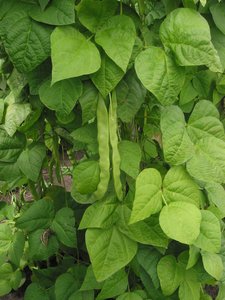
|
Common bean |
2-11
Annual
Full sun
Moist
Light (sandy), Medium, Heavy (clay)
2.0
Vines
Biomass, Dye, antifungal, Nitrogen fixer
true
Leaves, Seed, Seedpod
Seed - transplant, Seed - direct sow
https://en.wikipedia.org/wiki/Phaseolus_vulgaris
Pole bean, Climbing bean, French bean, Bush bean, Dwarf bean, Kidney bean, Green bean
Fabaceae, Leguminosae
Stangenbohne
https://pfaf.org/User/Plant.aspx?LatinName=Phaseolus vulgaris
16-18°c (70-80°f)
6.0-6.8
2.5 cm
16cm
4-10 days
45-85
Fast
Sperzieboon
Costa Rica, Guatemala, Honduras, Mexico Central, Mexico Gulf, Mexico Northeast, Mexico Northwest, Mexico Southeast, Mexico Southwest, Nicaragua, Panamá
Altay, Amur, Andaman Is., Angola, Argentina Northeast, Argentina Northwest, Assam, Baltic States, Bangladesh, Belarus, Bolivia, Bulgaria, Buryatiya, Cameroon, Cayman Is., Central European Rus, Chad, Chita, Colombia, Comoros, Cuba, Czechoslovakia, Dominican Republic, East European Russia, East Himalaya, Ecuador, Ethiopia, Guinea, Gulf of Guinea Is., Haiti, Illinois, India, Iraq, Irkutsk, Jamaica, Jawa, Kazakhstan, Kenya, Khabarovsk, Kirgizstan, Korea, Krasnoyarsk, Kuril Is., Leeward Is., Malaya, Marianas, Maryland, Mongolia, Myanmar, Nepal, New Guinea, New York, Nicobar Is., Nigeria, North Caucasus, North European Russi, Northwest European R, Pakistan, Peru, Philippines, Primorye, Puerto Rico, Queensland, Rwanda, Sakhalin, Senegal, South European Russi, Sri Lanka, Tadzhikistan, Tanzania, Thailand, Togo, Transcaucasus, Trinidad-Tobago, Turkmenistan, Tuva, Uganda, Ukraine, Uzbekistan, Venezuela, Vietnam, Wake I., West Himalaya, West Siberia, Yakutskiya, Zambia, Zaïre
2-4 weeks before last frost
1 week after last frost, 12-14 weeks before first frost
3-5 years
0.4
https://powo.science.kew.org/taxon/urn:lsid:ipni.org:names:514191-1
Coffee, Condiment
|
This entry describes all varieties of the common bean. This includes vining and bush/darf variaties and can have different names depending on their style of growths (see alternate names). These include the kidney bean, the navy bean, the pinto bean, the French bean and the wax bean The common bean, scientific name Phaseolus vulgaris, is a herbaceous annual plant native to the Americas, specifically the regions extending from the southwestern United States to South America. It is a member of the Fabaceae (legume) family. The common bean has a range of different appearances, depending on the variety. Most varieties have a simple, erect stem that grows to a height of 20-60 cm. The leaves are typically green and consist of 3-5 oblong leaflets. The flowers are small and white, pink, or purple in color. The fruit is a legume, which contains the seeds. The common bean is typically a small plant, but some varieties can grow to be quite large, reaching heights of up to 2 meters. The plant grows relatively quickly, with the growing season typically lasting between 60-100 days. The common bean prefers well-drained soil and full sun, but can also grow in partial shade. It is sensitive to frost and should be planted after the last frost date in the spring. To cultivate the common bean successfully, a grower may need to ensure that the soil is adequately fertilized and provide support for the plant to climb, if necessary. The common bean is edible, with the seeds and the young pods being the most commonly consumed parts. The seeds can be cooked and eaten as a protein-rich vegetable, and the young pods can be eaten as a green vegetable. The edible parts can be stored after harvest by drying the seeds or by preserving the young pods in vinegar or oil. The common bean has many uses beyond being a food source. The plant can fix nitrogen in the soil, improving its fertility and making it a useful companion plant for other crops. The dried leaves and stems of the common bean can be used as mulch or as a source of organic matter. In some cultures, the fibers from the stems are used to make ropes or other weaving materials. Additionally, the plant has been used medicinally to treat a variety of ailments. The common bean is also valuable for wildlife. The flowers attract bees and other pollinators, and the plant provides food for a variety of insects, birds, and small mammals. ### Links [Beans Seed Starting Tips @ Harvest to Table](https://harvesttotable.com/beans-seed-starting-tips/) ### Propagation - direct sow Direct-sow beans in spring after all danger of frost has passed and soil is at least 16°C (60°F). In warm-winter regions, sow beans in late summer for harvest in winter. Time sowing so that beans come to harvest before the first frost. |
Show
Edit |
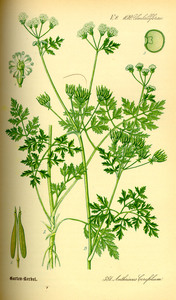
|
Anthriscus cerefolium |
https://en.wikipedia.org/wiki/Chervil
true
Moist
Full sun, Partial sun/shade, Full shade
6-9
Garden chervil
Light (sandy), Medium, Heavy (clay)
Apiaceae or umbelliferae
0.5
Echte kerbel
Leaves, Root
Biennial
https://pfaf.org/User/Plant.aspx?LatinName=Anthriscus cerefolium
Afghanistan, Albania, Algeria, Austria, Baleares, Belgium, Bulgaria, Canary Is., Corse, Cyprus, Czechoslovakia, Denmark, East Aegean Is., Egypt, France, Germany, Greece, Gulf States, Hungary, India, Iran, Iraq, Italy, Kazakhstan, Kirgizstan, Kriti, Krym, Lebanon-Syria, Libya, Madeira, Morocco, Netherlands, North Caucasus, Oman, Pakistan, Palestine, Poland, Portugal, Romania, Sardegna, Saudi Arabia, Sicilia, Sinai, Spain, Sweden, Switzerland, Tadzhikistan, Transcaucasus, Tunisia, Turkey, Turkey-in-Europe, Turkmenistan, Uzbekistan, West Himalaya, Xinjiang, Yugoslavia
Alabama, Argentina Northeast, Arizona, British Columbia, California, Chile Central, District of Columbia, Florida, Georgia, Great Britain, Ireland, Japan, Korea, Maryland, Massachusetts, Michigan, New Jersey, New South Wales, New York, New Zealand North, New Zealand South, North Carolina, Ohio, Ontario, Oregon, Pennsylvania, Rhode I., Saskatchewan, South Australia, South Carolina, South Dakota, Tasmania, Tennessee, Texas, Victoria, Washington
https://powo.science.kew.org/taxon/urn:lsid:ipni.org:names:40487-1
Condiment
Fragrance
|
Show
Edit |
|

|
Allium cepa |
3-9
Annual
Full sun
Moist
Light (sandy), Medium
0.6
Herbs
Flowers, Leaves, Root, Seed
Seed - direct sow, Seed - transplant
https://en.wikipedia.org/wiki/Onion
Garden onion
Alliaceae
Zwiebel
https://pfaf.org/User/Plant.aspx?LatinName=Allium cepa
50°f, 10°c
Seed indoors 6 weeks before transplanting in the garden
2-6 inches
6.0-7.0
Allium
Turkmenistan
Algeria, Argentina Northeast, Arkansas, Baltic States, Bangladesh, Belarus, Bulgaria, California, Cambodia, Canary Is., Central European Rus, China North-Central, China South-Central, China Southeast, Colombia, Cuba, Czechoslovakia, Dominican Republic, East Aegean Is., East European Russia, East Himalaya, Ecuador, Egypt, Ethiopia, Fiji, France, Galápagos, Guinea-Bissau, Haiti, Illinois, India, Iraq, Italy, Jamaica, Kansas, Kentucky, Kirgizstan, Korea, Krym, Libya, Louisiana, Madeira, Manchuria, Mauritania, Mexico Central, Mexico Gulf, Mexico Northeast, Mexico Southeast, Mexico Southwest, Minnesota, Montana, Morocco, New York, Niue, North European Russi, Northwest European R, Oregon, Pakistan, Puerto Rico, Seychelles, South European Russi, Spain, Tadzhikistan, Texas, Thailand, Tibet, Tonga, Trinidad-Tobago, Ukraine, Uzbekistan, Vermont, Washington, West Himalaya, West Siberia, Wisconsin, Xinjiang, Yugoslavia
Spring or fall
0.3
https://powo.science.kew.org/taxon/urn:lsid:ipni.org:names:527795-1
Cosmetic, Dye, Hair, Polish, Rust
true
|
Onion (Allium cepa) is a plant species in the family Amaryllidaceae. It is native to central Asia and is commonly grown as a vegetable in many parts of the world. Onions are biennial plants, meaning they typically have a two-year life cycle. In the first year, the onion forms a small, rounded bulb with thin, papery skin. In the second year, the onion will produce a tall stem with hollow, elongated leaves and a small, spherical flower head. Onions are typically grown for their bulbs, which are used as a food ingredient in many dishes. The bulbs can vary in size and shape, depending on the variety, but are generally spherical or oblong in shape and range in size from about 2-4 inches in diameter. Onions are commonly differentiated by their color, which can range from white to yellow to red. Onions prefer well-drained soil that is rich in organic matter. They should be planted in a sunny location and will benefit from regular watering, especially during dry periods. Onion bulbs can be harvested when they reach the desired size, typically after about 100-150 days of growth. To store onions, they should be dried and cured in a cool, dry place for about two weeks before being placed in a mesh bag or other breathable container. Onions are edible and are commonly used as a food ingredient in many dishes. The bulbs are the most commonly used part of the plant, but the leaves and stems can also be used in cooking. Onions have a pungent, spicy flavor and are often used to add flavor to soups, stews, and other dishes. Onions can be stored for several months if properly dried and cured. In addition to their use as a food ingredient, onions have also been used for their medicinal properties. They have been used to treat a variety of ailments, including coughs, colds, and respiratory infections. Onions are also sometimes used as a natural fertilizer, due to the high levels of sulfur and other nutrients they contain. Onions are not known to provide significant value to wildlife. They are not a preferred food source for most animals and do not provide any significant habitat value. However, some insects, such as the onion maggot, can be pests of onion crops. |
Show
Edit |

|
Rose |
2
Perennial
Full sun, Partial sun/shade
Deciduous
Shrubs
Animal feed, Attracts insects, Hedgerow, Wind breaker, Wildlife habitat
True
Fruit
Rosaceae
Zambia
https://powo.science.kew.org/taxon/urn:lsid:ipni.org:names:77120313-1
1
|
Show
Edit |
|
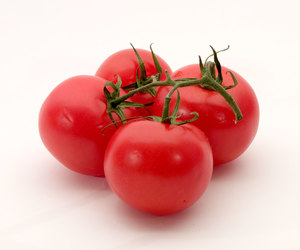
|
Tomato |
10-12
Annual, Perennial
Full sun
Moist
Light (sandy), Medium, Heavy (clay)
2.0
True
Fruit, Seed
https://en.wikipedia.org/wiki/Tomato
Fast
Garden tomato, Dumádu, Garden tomato, Love apple, Lycopersicum esculentum, Tomate, Tomato, Tomato extract containing lycopene, Tomato|thakkali, Tumatis, Lycopersicon esculentum
Solanaceae
Tomate
Oil
https://pfaf.org/User/Plant.aspx?LatinName=Solanum lycopersicum, https://pfaf.org/User/Plant.aspx?LatinName=Lycopersicon esculentum
Start seeds indoors 5-6 weeks before last frost
In containers or in rows in beds around last frost date
6.2-6.8
70-80°f
Peru
Alabama, Alaska, Andaman Is., Angola, Arizona, Arkansas, Assam, Austria, Azores, Bahamas, Bangladesh, Belarus, Benin, Bolivia, British Columbia, Bulgaria, Burkina, California, Cambodia, Cameroon, Canary Is., Cape Verde, Caroline Is., Central African Repu, Chagos Archipelago, Chatham Is., Christmas I., Colombia, Comoros, Connecticut, Cook Is., Costa Rica, Cuba, Cyprus, Czechoslovakia, Delaware, Dominican Republic, East Aegean Is., East European Russia, East Himalaya, Ecuador, Fiji, Florida, Galápagos, Georgia, Gilbert Is., Gulf of Guinea Is., Haiti, Hawaii, Illinois, India, Indiana, Iowa, Ivory Coast, Jawa, Kansas, Kazakhstan, Kentucky, Korea, Laccadive Is., Laos, Leeward Is., Line Is., Louisiana, Madagascar, Madeira, Maine, Malawi, Mali, Marianas, Marquesas, Marshall Is., Maryland, Massachusetts, Mauritania, Mauritius, Michigan, Mississippi, Missouri, Montana, Mozambique, Myanmar, Namibia, Nansei-shoto, Nauru, Nebraska, Nepal, Nevada, New Brunswick, New Caledonia, New Hampshire, New York, New Zealand North, Nicaragua, Nicobar Is., Niue, North Carolina, North Dakota, Nova Scotia, Ogasawara-shoto, Ohio, Ontario, Oregon, Pakistan, Panamá, Pennsylvania, Philippines, Pitcairn Is., Puerto Rico, Québec, Rhode I., Réunion, Saskatchewan, Selvagens, Society Is., South Carolina, South European Russi, Tadzhikistan, Taiwan, Tennessee, Texas, Trinidad-Tobago, Tuamotu, Tubuai Is., Turkey, Turkmenistan, Tuvalu, Utah, Uzbekistan, Venezuela, Vermont, Vietnam, Virginia, Wake I., Wisconsin, Zambia, Zaïre, Zimbabwe
1.00
https://powo.science.kew.org/taxon/urn:lsid:ipni.org:names:316947-2
|
The tomato is a flowering plant native to South America. It is a member of the nightshade family and closely related to the potato. The tomato plant typically grows to a height of 1-3 meters and has a weak, hairy stem. The leaves are arranged alternately on the stem and are typically dark green in color. The plant produces small yellow or white flowers, which develop into the fruit we know as tomatoes. The fruit itself is typically red, but can also be yellow, orange, green, or purple. Indeterminate tomato plants are perennials in their native habitat, but are cultivated as annuals. Determinate, or bush, plants are annuals that stop growing at a certain height and produce a crop all at once. Tomatoes prefer warm, sunny growing conditions and well-drained, humus-rich soil. They can be grown in a variety of soil types, but perform best in soil with a pH between 6 and 6.8. In order to cultivate tomatoes successfully, growers may need to provide support for the plant (such as a stake or cage) to prevent the fruit from weighing down the stem, and may also need to water and fertilize the plant regularly. Tomatoes are generally considered to be frost-sensitive, so in areas with cold winters they may need to be grown in a greenhouse or indoors. There are a great number of cultivars. The edible parts of the tomato plant are the fruit and the leaves. The fruit can be eaten raw or cooked, and is commonly used in a variety of dishes, such as salads, sandwiches, and pasta. The leaves, although not commonly eaten, are also edible and have a slightly bitter taste. After harvest, tomatoes can be stored at room temperature, in a cool place, or in the refrigerator. |
Show
Edit |

|
Chives |
3-12
Full sun, Partial sun/shade
Moist
Light (sandy), Medium, Heavy (clay)
6.0-7.0
0.3
0.45
Perennial
Herbs
Medium
8-12inches
Seed - direct sow, Seed - transplant, Division
4-6 weeks before last frost
14-21 days
21°c (70°f)
antifungal, Dynamic accumulator, Ground cover, Fragrance
true
Flowers, Leaves, Root
Wild chives, Flowering onion
Schnittlauch
Alliaceae
Allium
Afghanistan, Alaska, Albania, Alberta, Altay, Austria, Baltic States, Belarus, British Columbia, Bulgaria, Buryatiya, Central European Rus, Chita, Colorado, Connecticut, Corse, Czechoslovakia, Denmark, East European Russia, Finland, France, Germany, Great Britain, Greece, Idaho, Iran, Iraq, Irkutsk, Italy, Japan, Kamchatka, Kazakhstan, Khabarovsk, Korea, Krasnoyarsk, Kuril Is., Labrador, Magadan, Maine, Manitoba, Massachusetts, Michigan, Minnesota, Mongolia, Montana, Netherlands, New Brunswick, New Hampshire, New Jersey, New York, North Caucasus, North European Russi, Northwest European R, Northwest Territorie, Norway, Nova Scotia, Nunavut, Ohio, Ontario, Oregon, Pakistan, Pennsylvania, Poland, Portugal, Primorye, Prince Edward I., Québec, Rhode I., Romania, Sakhalin, Saskatchewan, South European Russi, Spain, Sweden, Switzerland, Tadzhikistan, Transcaucasus, Turkey, Tuva, Ukraine, Vermont, Washington, West Himalaya, West Siberia, Wisconsin, Wyoming, Xinjiang, Yakutskiya, Yugoslavia, Yukon
Argentina South, Azores, Belgium, Comoros, Cuba, Dominican Republic, Falkland Is., Haiti, Illinois, Ireland, Jamaica, Maryland, Newfoundland, Seychelles, Trinidad-Tobago
https://en.wikipedia.org/wiki/Chives
https://pfaf.org/User/Plant.aspx?LatinName=Allium schoenoprasum
https://powo.science.kew.org/taxon/urn:lsid:ipni.org:names:528823-1
|
Chives (Allium schoenoprasum) are a bulb-forming herbaceous perennial plants that belong to the same family as onions, garlic, and leeks. They are native to Europe, Asia, and North America, and are commonly grown in gardens for their delicate onion flavor and attractive purple flowers. Chives are easy to grow and require little maintenance. They can be grown in pots or containers, or directly in the ground. The plants have thin, hollow leaves that grow in tight clumps and reach a height of around 12-20 inches (30-50 cm). The bulbs are slender, conical, 2–3 cm (3⁄4–1 1⁄4 in) long and 1 cm (1⁄2 in) broad, and grow in dense clusters from the roots. The scapes (or stems) are hollow and tubular, up to 50 cm (20 in) long and 2–3 mm (1⁄16–1⁄8 in) across, with a soft texture, although, prior to the emergence of a flower, they may appear stiffer than usual. The grass-like leaves, which are shorter than the scapes, are also hollow and tubular, or terete, (round in cross-section) which distinguishes it at a glance from garlic chives (Allium tuberosum). The flowers are pale purple, and star-shaped with six petals, 1–2 cm (1⁄2–3⁄4 in) wide, and produced in a dense inflorescence of 10-30 together; before opening, the inflorescence is surrounded by a papery bract. The seeds are produced in a small, three-valved capsule, maturing in summer. The herb flowers from April to May in the southern parts of its habitat zones and in June in the northern parts. Chives are often used as a seasoning in a variety of dishes, including soups, omelets, and dips. They can also be added to melted butter to make a simple but flavorful sauce for steamed vegetables. Chives are low in calories and a good source of vitamin C, making them a healthy addition to any diet. |
Show
Edit |
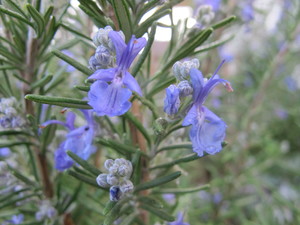
|
Rosemary |
6-11
Perennial
Full sun
Dry, Moist
Light (sandy), Medium
Evergreen
1.5
Herbs
Attracts insects, Hedgerow
true
Leaves
https://en.wikipedia.org/wiki/Rosemary
Medium
Lamiaceae or labiatae
true
Rosmarinus officinale, rosmarinus officinalis
https://pfaf.org/User/Plant.aspx?LatinName=Rosmarinus officinalis
Albania, Algeria, Baleares, Corse, Cyprus, East Aegean Is., Egypt, France, Greece, Italy, Libya, Morocco, Portugal, Sardegna, Sicilia, Spain, Tunisia, Turkey, Yugoslavia
Azores, Bermuda, Bulgaria, Canary Is., Cape Verde, Germany, Great Britain, Kriti, Krym, Madeira, Mexico Central, Mexico Southwest, Texas, Trinidad-Tobago
1.2
https://powo.science.kew.org/taxon/urn:lsid:ipni.org:names:457138-1
|
Rosemary (Salvia rosmarinus) is a woody, perennial herb native to the Mediterranean region. It is an evergreen shrub that grows to a height of 1-2 meters and has narrow, linear leaves that are about 2-4 cm long and 1-2 mm wide. The leaves are dark green in color and have a strong, pungent aroma. The flowers of rosemary are blue, purple, or white in color and grow in clusters on the tips of the branches. Rosemary prefers well-drained soil and full sun, and it grows best in temperate climates. It can be grown in a variety of soil types, including sandy and loamy soils, but it does not tolerate wet or waterlogged conditions. To cultivate rosemary successfully, the plant should be watered regularly during the growing season and pruned regularly to maintain its shape. Rosemary's leaves are edible and can be used as a seasoning in a variety of dishes. The leaves can be dried and stored for later use, or they can be used fresh. They can also be used to make tea. Rosemary has a number of uses, including as a medicinal herb and as a source of essential oils. It has been used to treat a variety of ailments, including indigestion, headaches, and muscle pain. It has also been used to improve memory and cognitive function. In addition, rosemary has been used as a fertility aid and to improve circulation. Rosemary is not particularly valuable as a food source for wildlife, but it can provide shelter and habitat for a variety of animals. It is often used as a decorative plant in gardens and landscaping. |
Show
Edit |
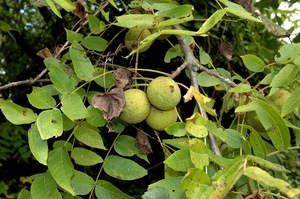
|
Black walnut |
4-9
Perennial
Full sun
Moist
Light (sandy), Medium, Heavy (clay)
30.0
Tall trees
Crafting, Compost, Dye, Filter, Herbicide, Pest control, oil, Tannin, Lumber, Dynamic accumulator, Fragrance
true
Sap, Seed
https://en.wikipedia.org/wiki/Juglans_nigra
Fast
Juglandaceae
Schwarznuss
True
Oil, Sweetener
https://pfaf.org/User/Plant.aspx?LatinName=Juglans nigra
Alabama, Arkansas, Connecticut, Delaware, District of Columbia, Florida, Georgia, Illinois, Indiana, Iowa, Kansas, Kentucky, Louisiana, Maryland, Massachusetts, Michigan, Minnesota, Mississippi, Missouri, Nebraska, New Jersey, New York, North Carolina, Ohio, Oklahoma, Ontario, Pennsylvania, Rhode I., South Carolina, South Dakota, Tennessee, Texas, Virginia, West Virginia, Wisconsin
Austria, Belgium, Bulgaria, Czechoslovakia, Denmark, Germany, Hungary, Italy, New Mexico, North Caucasus, Poland, Romania, Tadzhikistan, Transcaucasus, Vermont, West Himalaya
https://powo.science.kew.org/taxon/urn:lsid:ipni.org:names:279034-2
|
Black walnut is a large deciduous tree native to North America, growing up to 100 feet tall. It has a straight trunk with a rough, deeply furrowed bark, and a canopy of large, pinnately compound leaves with 15-23 lance-shaped leaflets. The tree produces large, greenish-white flowers in the spring, followed by large, spherical fruits containing a single, edible nut. Black walnuts are prized for their distinctive, rich flavor and are commonly used in baking and cooking. The nuts can be harvested in the fall and can be stored in their shells for several months. Black walnuts prefer deep, well-drained soils and can tolerate a wide range of soil pH levels. They can be grown successfully in full sun to partial shade, and they are relatively drought-tolerant once established. Black walnuts are not particularly winter hardy, and they can be damaged by heavy ice and snow. In addition to their culinary uses, black walnuts have a number of other uses. The wood is highly prized for its durability and attractive grain, and is used in furniture making and other woodworking applications. The tree's leaves, bark, and nuts are also used in herbal medicine for their astringent and tonic properties. Black walnuts are also valued for their ability to improve soil health, as their deep taproots help to break up compacted soils and their fallen leaves add organic matter to the soil. Black walnuts are also an important food source for wildlife, including squirrels, birds, and deer. The tree provides shelter and nesting sites for a variety of animals, and its fallen leaves and nuts provide food for many species. |
Show
Edit |

|
Chili |
9-11
Annual, Perennial
Full sun
Moist
Light (sandy), Medium
60-90cm
Herbs
Fruit
Seed - direct sow, Seed - transplant
1 week after last frost
https://en.wikipedia.org/wiki/Bird%27s_eye_chili
6.0-6.5
80-85
40cm
Heart
24°c
7-21 days
Solanaceae
Guatemala, Mexico Central, Mexico Gulf, Mexico Northeast, Mexico Northwest, Mexico Southeast, Mexico Southwest
Alabama, Aldabra, Algeria, Andaman Is., Angola, Assam, Austria, Bahamas, Bangladesh, Belize, Benin, Bismarck Archipelago, Bolivia, Borneo, Botswana, Brazil North, Brazil Northeast, Bulgaria, Burundi, Cambodia, Cameroon, Canary Is., Cape Verde, Caroline Is., Cayman Is., Central African Repu, Chad, Colombia, Comoros, Congo, Cook Is., Costa Rica, Cuba, Djibouti, Dominican Republic, East Himalaya, Ecuador, El Salvador, Equatorial Guinea, Eritrea, Ethiopia, Fiji, Gabon, Galápagos, Gambia, Ghana, Gilbert Is., Greece, Guinea-Bissau, Gulf of Guinea Is., Guyana, Haiti, Honduras, India, Ivory Coast, Jawa, Kazakhstan, Kazan-retto, Kenya, Korea, Laos, Leeward Is., Line Is., Madagascar, Madeira, Maldives, Mali, Marianas, Marquesas, Marshall Is., Maryland, Mauritius, Morocco, Myanmar, Nepal, New Guinea, New South Wales, New York, Nicobar Is., Niger, Nigeria, Northern Provinces, Northern Territory, Oman, Pakistan, Panamá, Peru, Philippines, Puerto Rico, Queensland, Rodrigues, Réunion, Senegal, Sierra Leone, Society Is., Solomon Is., Somalia, South European Russi, Southwest Caribbean, Sri Lanka, Sulawesi, Suriname, Tadzhikistan, Tanzania, Togo, Trinidad-Tobago, Tuamotu, Tunisia, Turkey, Turkmenistan, Turks-Caicos Is., Uganda, Uzbekistan, Vanuatu, Venezuela, Vietnam, Wake I., West Himalaya, Windward Is., Zambia, Zaïre, Zimbabwe
4-12 weeks before last frost
https://powo.science.kew.org/taxon/urn:lsid:ipni.org:names:316944-2
|
Chili, also known as Capsicum annuum, is a flowering plant in the nightshade family Solanaceae. It is native to the Americas, where it has been cultivated for thousands of years. Though the scientific name hints at it being an annual plant, it can be grown perennially if you are in USDA hardiness zone 9-11. Chili plants typically grow to a height of 1-2 feet and have oval-shaped, glossy leaves. The flowers are small and white, and the fruit, which are commonly referred to as chili peppers, can vary in color and size. Chili peppers can be red, yellow, green, or purple and can be as small as a pea or as large as a banana. Chili plants prefer warm, sunny growing conditions and well-draining soil. To cultivate chili peppers successfully, gardeners will need to provide these conditions and also ensure that the plants receive enough water. Chili peppers are not winter hardy, so they will need to be brought indoors or grown in a greenhouse during the colder months. Chili peppers are edible and are commonly used in cooking to add heat and flavor to dishes. The fruits can be eaten fresh or dried, and they can also be ground into a powder to make chili powder. The leaves and stems of the plant are not typically eaten. In addition to their culinary uses, chili peppers have a number of other uses. They have been used medicinally to treat a variety of conditions, including toothaches and respiratory problems. Chili peppers can also be used as a natural insect repellent, and the plants can provide habitat and food for a variety of birds and insects. |
Show
Edit |

|
Papalo Quelite |
Leaves
antifungal
Herbs
10-11
Annual
Full sun, Partial sun/shade
Dry, Moist
Light (sandy), Medium, Heavy (clay)
5 feet
http://tropical.theferns.info/viewtropical.php?id=Porophyllum+ruderale
Asteraceae
Yerba Porosa, Quilquina, Bolivian Coriander, Papalo, Killi, Summer Cilantro
antiinflammatory; roots as pain relief from rheumatism and erysipelas
21°C (70°F)
7-21 days
Seed - direct sow, Seed - transplant
May and later
seed indoors and plant outside when 6 inch tall
Argentina Northeast, Argentina Northwest, Arizona, Aruba, Bahamas, Bolivia, Brazil North, Brazil Northeast, Brazil South, Brazil Southeast, Brazil West-Central, Cayman Is., Chile North, Colombia, Costa Rica, Cuba, Dominican Republic, Ecuador, El Salvador, French Guiana, Galápagos, Guatemala, Guyana, Haiti, Honduras, Jamaica, Leeward Is., Mexico Central, Mexico Gulf, Mexico Northeast, Mexico Northwest, Mexico Southeast, Mexico Southwest, Netherlands Antilles, New Mexico, Nicaragua, Panamá, Paraguay, Peru, Puerto Rico, Suriname, Texas, Trinidad-Tobago, Uruguay, Venezuela, Venezuelan Antilles, Windward Is.
China Southeast, Ivory Coast, Jawa, Lesser Sunda Is., Malaya, New Guinea, Queensland, Réunion
https://powo.science.kew.org/taxon/urn:lsid:ipni.org:names:208446-2
|
An annual native to Mexico through South America. Leaves are strongly aromatic and can be used as a seasoning. |
Show
Edit |
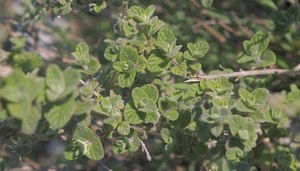
|
Origanum vulgare |
4-10
Full sun, Partial sun/shade
Dry, Moist
Light (sandy), Medium, Heavy (clay)
4.5–8.7
0.6
0.6
Perennial
Herbs
Medium
20cm
true
Flowers, Leaves, Stem
Condiment, Tea
Pot Marjoram
Lamiaceae or Labiatae
Afghanistan, Albania, Algeria, Altay, Austria, Azores, Baleares, Baltic States, Belarus, Belgium, Bulgaria, Buryatiya, Canary Is., Central European Rus, China North-Central, China South-Central, China Southeast, Corse, Cyprus, Czechoslovakia, Denmark, East Aegean Is., East European Russia, East Himalaya, Finland, France, Germany, Great Britain, Greece, Hungary, India, Iran, Iraq, Ireland, Irkutsk, Italy, Kazakhstan, Kirgizstan, Krasnoyarsk, Kriti, Krym, Madeira, Morocco, Nepal, Netherlands, North Caucasus, North European Russi, Northwest European R, Norway, Pakistan, Poland, Portugal, Romania, Sardegna, Sicilia, South European Russi, Spain, Svalbard, Sweden, Switzerland, Tadzhikistan, Taiwan, Tibet, Transcaucasus, Tunisia, Turkey, Turkey-in-Europe, Turkmenistan, Tuva, Ukraine, Uzbekistan, West Himalaya, West Siberia, Xinjiang, Yakutskiya, Yugoslavia
Arkansas, British Columbia, California, Connecticut, Delaware, Illinois, Maryland, Massachusetts, Mexico Southwest, Michigan, New Jersey, New York, New Zealand South, North Carolina, Nova Scotia, Ohio, Ontario, Oregon, Pennsylvania, Primorye, Prince Edward I., Québec, Venezuela, Vermont, Virginia, Washington
https://en.wikipedia.org/wiki/Oregano
https://pfaf.org/User/Plant.aspx?LatinName=Origanum vulgare
https://powo.science.kew.org/taxon/urn:lsid:ipni.org:names:453395-1
best in late Spring; softwood cuttings root fastest
true
Dye, Essential Oil, Pest control, Strewing, Dynamic accumulator, Ground cover, Fragrance
|
Oregano, also known as Origanum vulgare, is a herb that is native to the Mediterranean region. It is a small, bushy plant that grows to a height of about 1 to 2 feet and has a woody stem. The leaves are oval-shaped and are covered in small hairs. The flowers are small and white or purple in color and grow in clusters. Oregano grows best in well-drained, fertile soil in a sunny location. It is winter hardy and can withstand cold temperatures. To cultivate oregano successfully, a grower may need to provide adequate watering and sunlight, and may also need to prune the plant regularly to keep it from becoming leggy. The leaves of the oregano plant are edible and can be used fresh or dried in cooking. They have a strong, pungent flavor and are commonly used in Italian, Greek, and Mexican cuisine. The leaves can be stored after harvest by drying them and storing them in an airtight container. In addition to its use in cooking, oregano has also been used in traditional medicine to treat a variety of conditions, including respiratory problems and digestive issues. It is also known to attract pollinators, making it valuable for wildlife. |
Show
Edit |
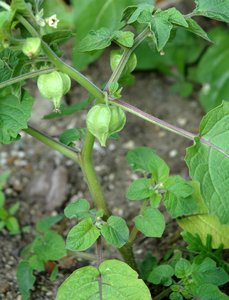
|
Strawberry Tomato |
4-8
Full sun, Partial sun/shade
Dry, Moist
Light (sandy), Medium, Heavy (clay)
6-6.8
0.6
Annual, Perennial
Herbs
60cm
6-8 weeks before last frost
Attracts pollinators
true
Fruit
Ground cherry, Caped gooseberry
Solanaceae
Central America, Argentina Northeast, Argentina Northwest, Costa Rica, El Salvador, Guatemala, Honduras, Mexico Central, Mexico Gulf, Mexico Northeast, Mexico Northwest, Mexico Southeast, Mexico Southwest, Nicaragua, Paraguay, Venezuela
Bolivia, Brazil Northeast, India, Ogasawara-shoto
https://en.wikipedia.org/wiki/Physalis_pruinosa
https://pfaf.org/User/Plant.aspx?LatinName=Physalis pruinosa
https://powo.science.kew.org/taxon/urn:lsid:ipni.org:names:317701-2
0.6
65-75
|
Physalis pruinosa, also known as the ground cherry, is a plant native to North America. It is a small, herbaceous plant that typically grows to be about 1-2 feet tall. The leaves are oval-shaped and about 2-4 inches long. The plant produces small, yellow flowers, followed by a fruit encased in a papery husk. The fruit is about the size of a cherry tomato and is edible. In terms of growing conditions, Physalis pruinosa prefers well-drained, sandy soil and full sun to partial shade. It is not winter hardy and will die back in cold weather, but will regrow from the roots in the spring. To cultivate the plant successfully, a grower will need to provide these ideal growing conditions and may need to protect the plant from frost in colder climates. The fruit of Physalis pruinosa is edible and can be eaten fresh or cooked. It has a sweet and tangy flavor. The fruit can be stored by removing it from the husk and keeping it in a cool, dry place. In addition to being eaten, the fruit of Physalis pruinosa can also be used in jams and jellies. The plant has some medicinal uses as well, including treating stomach ailments and respiratory issues. It is also valued by wildlife, providing food for birds and small mammals. ### Links [Ground cherry @ Gardener's Path](https://gardenerspath.com/plants/fruit/grow-ground-cherries/) [How to grow ground cherries @ Growing in the Garden](https://growinginthegarden.com/how-to-grow-ground-cherries-10-tips-for-growing-ground-cherries/) |
Show
Edit |